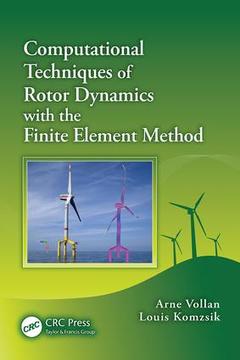Computational Techniques of Rotor Dynamics with the Finite Element Method Computational Techniques of Engineering Series
Auteurs : Vollan Arne, Komzsik Louis

For more than a century, we have had a firm grasp on rotor dynamics involving rigid bodies with regular shapes, such as cylinders and shafts. However, to achieve an equally solid understanding of the rotational behavior of flexible bodies?especially those with irregular shapes, such as propeller and turbine blades?we require more modern tools and methods.
Computational Techniques of Rotor Dynamics with the Finite Element Method explores the application of practical finite element method (FEM)-based computational techniques and state-of-the-art engineering software. These are used to simulate behavior of rotational structures that enable the function of various types of machinery?from generators and wind turbines to airplane engines and propellers.
The book?s first section focuses on the theoretical foundation of rotor dynamics, and the second concentrates on the engineering analysis of rotating structures. The authors explain techniques used in the modeling and computation of the forces involved in the rotational phenomenon. They then demonstrate how to interpret and apply the results to improve fidelity and performance.
Coverage includes:
- Use of FEM to achieve the most accurate computational simulation of all gyroscopic forces occurring in rotational structures
- Details of highly efficient and accurate computational and numerical techniques for dynamic simulations
- Interpretation of computational results, which is instrumental to developing stable rotating machinery
- Practical application examples of rotational structures? dynamic response to external and internal excitations
- An FEM case study that illustrates the computational complexities associated with modeling and computation of forces of rotor dynamics
- Assessment of propellers and turbines that are critical to the transportation and energy industries
Useful to practicing engineers and graduate-level students alike, this self-contained volume also serves as an invaluable reference for researchers and instructors in this field.
CRC Press Authors Speak
Louis Komzsik introduces you to two books that share a common mathematical foundation, the finite element analysis technique. Watch the video.
Part I: Theoretical Foundation of Rotor Dynamics
Introduction to Rotational Physics. Coupled Solution Formulations. Finite Element Analysis of Rotating Structures. Computational Solution Techniques. Numerical Solution Techniques.
Part II: Engineering Analysis of Rotating Structures
Resonances and Instabilities. Dynamic Response Analysis. A Finite Element Case Study. Analysis of Aircraft Propellers. Analysis of Wind Turbines.
Arne Vollan studied aeronautical engineering at the Technical University of Trondheim (Norway) and Aachen (Germany), and holds the degree Diplom Ingenieur. He was employed by several aeronautical companies such as VFW-Fokker (now Airbus), Helicopter Technik Muenchen, Dornier, Nationaal Lucht- en Ruimtevaartlaboratorium, and Pilatus Aircraft as a dynamic and aeroelastic specialist. He was also a consultant and developed programs for the analysis of rotating structures like wind turbines and propellers. Since 2002 he has been working at AeroFEM GmbH in Switzerland on rotor dynamics and the aeroelasticity of aircraft and large wind turbines.
Louis Komzsik is a graduate of the Technical University of Budapest with an engineering degree and the Eötvös University of Sciences in Budapest with a mathematics degree, and he holds a Doctorate from the Technical University of Budapest, Hungary. He was employed by the Hungarian Shipyards from 1972 to 1980 and worked at the McDonnell-Douglas Corporation in 1981 and 1982. He was the chief numerical analyst at the MacNeal-Schwendler (now MSC Software) Corporation for two decades. Since 2003 he has been the chief numerical analyst at Siemens PLM Software. For the past 30 years he has been the architect of the modern numerical methods of NASTRAN, the world’s leading finite element analysis tool in structural engineering.
Date de parution : 04-2017
15.6x23.4 cm
Date de parution : 04-2012
Ouvrage de 282 p.
15.6x23.4 cm
Mots-clés :
Elastic Potential Energy; Tip Speed Ratio; Computational Solution Techniques; Location Vector; Theoretical Foundation Of Rotor Dynamics; Campbell Diagram; Engineering Analysis Of Rotating Structures; Flap Modes; Excitation Function; Critical Speeds; Backward Whirl; Forward Whirl; Elastic Axis; Aerodynamic Forces; Rotor Speed; Unsteady Aerodynamic Forces; Pk Method; Geometric Stiffness Matrix; Ff Fh; Oo Oa; Ao Aa; Stiffness Matrix; Wind Turbine; Lag Mode; Qu En; D1 Matrix; Ei Ge; Aerodynamic Stiffness



